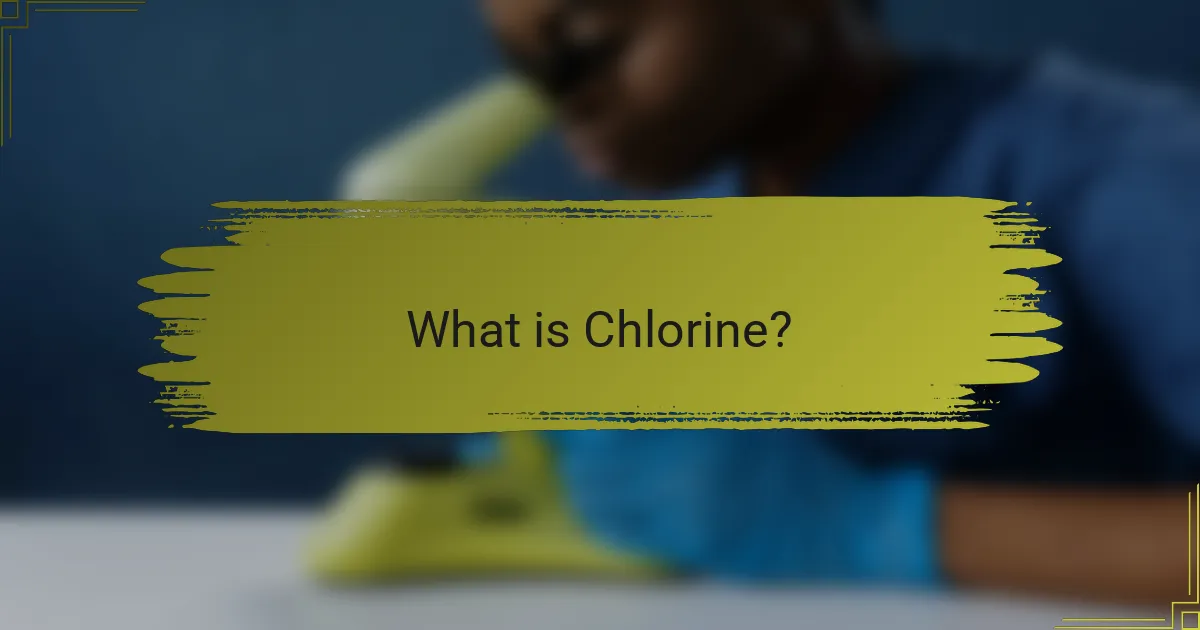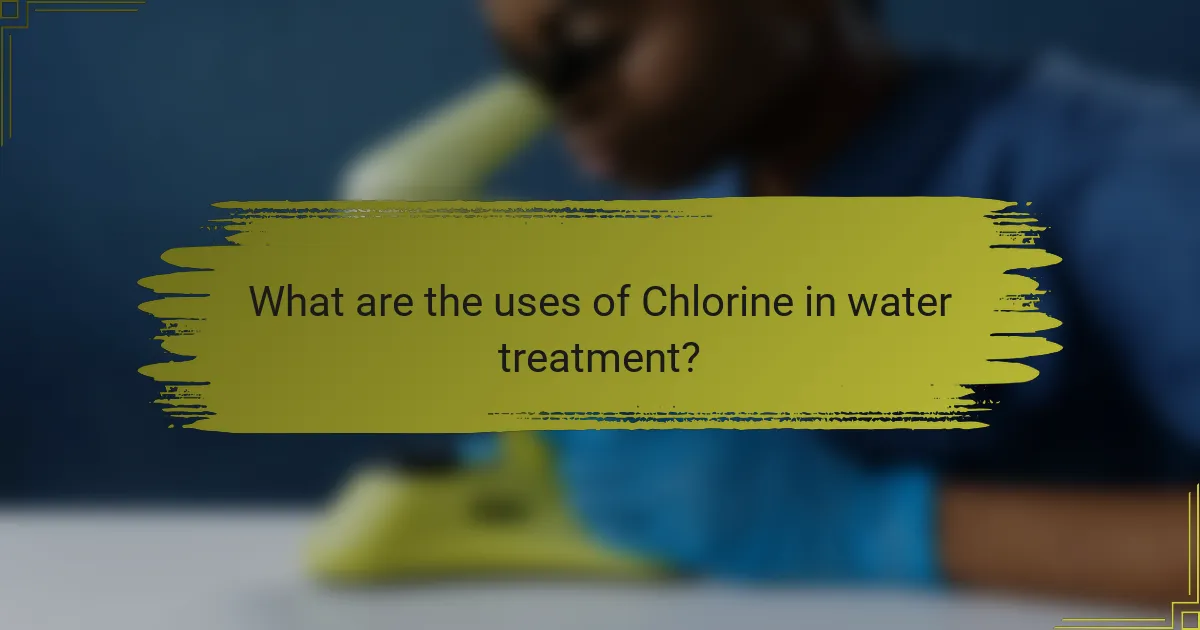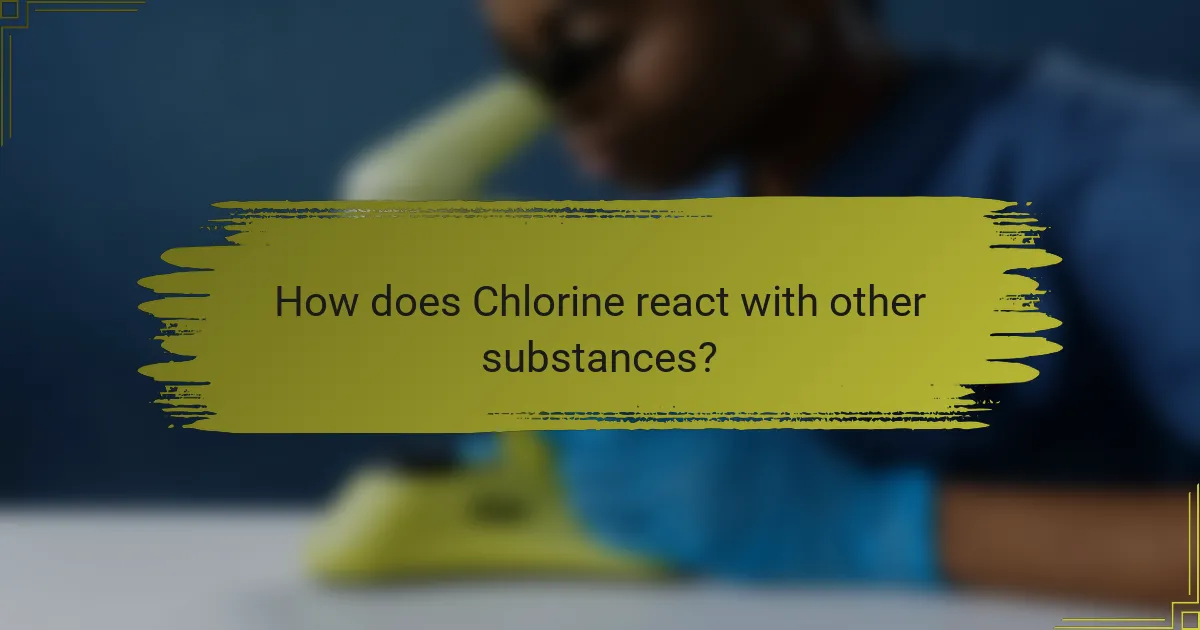
What is Chlorine?
Chlorine is a chemical element with the symbol Cl and atomic number 17. It is a yellow-green gas at room temperature. Chlorine is highly reactive and belongs to the halogen group in the periodic table. It is commonly used for disinfection in water treatment processes. Chlorine gas can form various compounds, including sodium chloride, when it reacts with other elements. Chlorine is essential for killing bacteria and pathogens in drinking water. Its effectiveness in sanitation is well-documented in public health studies. Chlorine’s reactivity also makes it useful in the production of various chemicals and plastics.
How is Chlorine classified in chemistry?
Chlorine is classified as a chemical element in the periodic table. It has the symbol Cl and atomic number 17. Chlorine belongs to the group of halogens. Halogens are found in Group 17 of the periodic table. Chlorine exists as a diatomic molecule (Cl2) in its gaseous form. It is a yellow-green gas at room temperature. Chlorine is highly reactive and can form compounds with many elements. Its reactivity is due to its electron configuration, which seeks to achieve a stable octet.
What are the physical states of Chlorine at different temperatures?
Chlorine exists in different physical states depending on temperature. At temperatures above -34 degrees Celsius, chlorine is a gas. This gaseous state is common at room temperature. Below -34 degrees Celsius, chlorine transitions into a yellow-green liquid. The liquid state occurs at temperatures between -34 degrees Celsius and -101 degrees Celsius. Finally, at temperatures below -101 degrees Celsius, chlorine solidifies into a yellow-green solid. These physical states are consistent with chlorine’s phase diagram, which outlines its state changes based on temperature and pressure conditions.
What are the key physical properties of Chlorine?
Chlorine is a greenish-yellow gas at room temperature. It has a distinct, pungent odor. Chlorine is highly reactive and a strong oxidizing agent. Its molecular formula is Cl2, indicating it exists as a diatomic molecule. The boiling point of chlorine is -34.04 degrees Celsius. Its melting point is -101.5 degrees Celsius. Chlorine is soluble in water, with a solubility of about 0.7 g/100 mL at 25 degrees Celsius. Chlorine gas is approximately 2.5 times denser than air.
Why is Chlorine important in various applications?
Chlorine is important in various applications due to its effectiveness as a disinfectant and bleaching agent. It is widely used in water treatment to kill harmful bacteria and viruses. Chlorine ensures safe drinking water by eliminating pathogens. In swimming pools, chlorine maintains water hygiene and clarity. The chemical is also used in the production of household bleach and other cleaning products. Chlorine compounds are essential in the manufacturing of plastics, such as PVC. Additionally, chlorine plays a role in the production of pharmaceuticals and agrochemicals. Its versatility and effectiveness make chlorine a critical component across multiple industries.
What role does Chlorine play in water treatment processes?
Chlorine plays a crucial role in water treatment processes as a disinfectant. It effectively kills bacteria, viruses, and other pathogens present in water. Chlorine is commonly used in various forms, including chlorine gas, sodium hypochlorite, and calcium hypochlorite. The disinfection process typically occurs during the initial stages of water treatment. Chlorine reacts with organic matter in the water, forming chlorinated compounds. These compounds help maintain water quality during distribution. According to the U.S. Environmental Protection Agency, chlorine is one of the most widely used disinfectants in drinking water treatment. Its effectiveness ensures safe drinking water for millions of people.
How does Chlorine contribute to public health and safety?
Chlorine contributes to public health and safety primarily by disinfecting drinking water. It effectively kills harmful pathogens, including bacteria and viruses. This disinfection process significantly reduces the risk of waterborne diseases. According to the World Health Organization, chlorine has been instrumental in preventing outbreaks of cholera and typhoid. Chlorine is also used in swimming pools to maintain water quality. It helps to eliminate contaminants and ensure safe recreational environments. The use of chlorine in water treatment has been a standard practice since the early 20th century. Its effectiveness and low cost make it a preferred choice for public health initiatives.

What are the uses of Chlorine in water treatment?
Chlorine is primarily used in water treatment for disinfection. It effectively kills bacteria, viruses, and other pathogens in drinking water. Chlorine also helps in the removal of organic and inorganic contaminants. It reacts with impurities to form chlorinated compounds, which further enhance water quality. The use of chlorine in water treatment dates back to the early 20th century. Studies show that chlorination reduces waterborne diseases significantly. Chlorine is often used in combination with other treatment methods for optimal efficacy. Its application is regulated to ensure safety and effectiveness in public water supplies.
How is Chlorine utilized in municipal water systems?
Chlorine is utilized in municipal water systems primarily for disinfection purposes. It effectively eliminates harmful bacteria and viruses present in water. Chlorination helps ensure that drinking water is safe for public consumption. The process typically involves adding chlorine gas or sodium hypochlorite to the water supply. This treatment occurs at water treatment plants before distribution. Chlorine reacts with pathogens, disrupting their cellular processes. Studies show that chlorination significantly reduces waterborne diseases. For example, the Centers for Disease Control and Prevention (CDC) reported a decrease in outbreaks due to chlorination practices. Overall, chlorine plays a crucial role in maintaining water quality and public health.
What are the methods of Chlorine application in water treatment?
Chlorine application in water treatment includes several methods. The primary methods are gas chlorination, liquid chlorination, and hypochlorite application. Gas chlorination involves introducing chlorine gas directly into water. This method is highly effective for large water systems. Liquid chlorination uses sodium hypochlorite or calcium hypochlorite solutions. It is easier to handle and safer than gas. Hypochlorite application involves using pre-mixed solutions of hypochlorite. This method is common in smaller systems. Each method effectively disinfects water and removes contaminants. Chlorine application is crucial for maintaining safe drinking water standards.
What are the benefits of using Chlorine in water purification?
Chlorine is widely used in water purification due to its effectiveness in killing harmful microorganisms. It eliminates bacteria, viruses, and protozoa, making water safe for consumption. Chlorine also helps in controlling algae growth in water systems. Its residual effect ensures ongoing disinfection even after initial treatment. Chlorination is a cost-effective method compared to other purification techniques. Studies show that chlorine can reduce waterborne diseases significantly. For instance, the World Health Organization reports that chlorination can decrease cholera incidence by up to 80%. Overall, chlorine is a reliable and efficient agent in maintaining water quality.
What are the potential risks associated with Chlorine use?
Chlorine use poses several potential risks. Exposure can lead to respiratory issues, including asthma and irritation of the airways. Chlorine gas is toxic and can cause coughing and choking. Skin contact may result in burns or rashes. Ingesting chlorine can lead to gastrointestinal distress and damage to internal organs. Prolonged exposure may increase the risk of certain cancers. Chlorinated water can form harmful byproducts, such as trihalomethanes, which have been linked to health concerns. Safety measures, such as proper ventilation and protective equipment, are essential to mitigate these risks.
How can Chlorine exposure affect human health?
Chlorine exposure can lead to various health effects. Short-term exposure may cause respiratory issues, including coughing and throat irritation. High concentrations can result in more severe respiratory problems, such as pulmonary edema. Skin and eye irritation are also common symptoms from direct contact. Long-term exposure may increase the risk of respiratory diseases. Studies indicate that chlorine can react with organic materials to form harmful byproducts, such as trihalomethanes, which are linked to health risks. The U.S. Environmental Protection Agency (EPA) has set limits on chlorine levels in drinking water to mitigate these risks.
What safety measures should be taken when handling Chlorine?
When handling chlorine, use appropriate personal protective equipment (PPE). This includes gloves, goggles, and respiratory protection. Ensure adequate ventilation in the workspace to avoid inhalation of fumes. Store chlorine in a cool, dry place away from incompatible substances. Use chlorine in well-ventilated areas to minimize exposure risks. Familiarize yourself with emergency procedures in case of accidental exposure. According to the CDC, chlorine can cause respiratory issues and skin irritation, highlighting the importance of these safety measures. Always have safety data sheets available for reference.

How does Chlorine react with other substances?
Chlorine reacts vigorously with many substances. It is a strong oxidizing agent. Chlorine can react with metals, forming metal chlorides. For example, chlorine reacts with sodium to produce sodium chloride. It can also react with nonmetals, such as hydrogen, to form hydrogen chloride. In water, chlorine forms hypochlorous acid, which is effective for disinfection. Chlorine can also react with organic compounds, leading to chlorinated byproducts. These reactions can produce toxic compounds, emphasizing the need for careful handling.
What are the common chemical reactions involving Chlorine?
Chlorine commonly undergoes several chemical reactions. One significant reaction is its combination with hydrogen to form hydrogen chloride (HCl). This reaction occurs when chlorine gas reacts with hydrogen gas in a exothermic reaction. Another common reaction is the chlorination of alkanes, where chlorine replaces hydrogen atoms in the alkane molecule. This substitution reaction is initiated by UV light or heat. Chlorine also reacts with sodium to produce sodium chloride (NaCl), a vital compound in cooking and food preservation. Additionally, chlorine can react with water to form hypochlorous acid (HOCl) and hydrochloric acid (HCl), which are used for disinfection purposes. These reactions illustrate chlorine’s reactivity and its role in various chemical processes.
How does Chlorine react with organic compounds?
Chlorine reacts with organic compounds primarily through a process called halogenation. This reaction typically involves the substitution of hydrogen atoms in the organic molecule with chlorine atoms. Chlorination can lead to the formation of chlorinated organic compounds, which may have different chemical properties than the original compounds.
In many cases, chlorine reacts with alkenes and alkynes through electrophilic addition, resulting in the formation of vicinal dihalides. Chlorine can also react with aromatic compounds, leading to electrophilic aromatic substitution.
These reactions are significant in various applications, including disinfection and the synthesis of chemical intermediates. Chlorinated compounds often exhibit increased stability and altered reactivity compared to their non-chlorinated counterparts.
What are the implications of Chlorine’s reactivity in water treatment?
Chlorine’s reactivity in water treatment leads to effective disinfection and potential formation of harmful byproducts. Chlorine reacts with organic matter in water, producing chlorinated compounds. These compounds can include trihalomethanes (THMs) and haloacetic acids (HAAs), which are regulated due to their health risks. The reactivity of chlorine also helps eliminate pathogens like bacteria and viruses, ensuring safe drinking water. However, the balance between effective disinfection and byproduct formation is crucial. Monitoring chlorine levels and water quality is essential to minimize health risks while maintaining effective treatment.
How can we effectively manage Chlorine in water treatment systems?
Chlorine management in water treatment systems can be effectively achieved through precise dosing and monitoring. Accurate chlorine dosing ensures optimal disinfection without harmful byproducts. Continuous monitoring of chlorine levels helps maintain the desired concentration, typically between 1-4 mg/L for safe drinking water. Additionally, utilizing automated control systems can enhance dosing accuracy and reduce human error. Regular maintenance of chlorine injection equipment is essential to prevent malfunctions. Implementing a residual chlorine testing program can verify effective treatment. Furthermore, using dechlorination methods can mitigate chlorine’s impact on the environment when discharging treated water. Studies show that proper chlorine management reduces the formation of trihalomethanes, a group of harmful disinfection byproducts.
What best practices should be followed for Chlorine dosage?
Chlorine dosage should be based on accurate water testing and specific treatment goals. Regularly test water for pH and chlorine levels to ensure proper dosage. The ideal free chlorine level for swimming pools is typically between 1 to 3 ppm. For drinking water, maintain a residual chlorine level of 0.2 to 4 ppm. Adjust dosage according to water temperature and organic load. Always add chlorine to water, not the other way around, to prevent hazardous reactions. Follow manufacturer guidelines for specific chlorine products. Use appropriate safety gear when handling chlorine to prevent exposure.
How can we troubleshoot common issues related to Chlorine in water treatment?
To troubleshoot common issues related to chlorine in water treatment, first identify the specific problem. Common issues include chlorine odor, low chlorine levels, and chlorine by-products. For chlorine odor, check if chlorine levels exceed recommended limits. Adjust levels accordingly. Low chlorine levels may result from insufficient dosing or high organic matter. Increase chlorine dosage or reduce organic load. Chlorine by-products, like chloramines, can cause water quality issues. Use breakpoint chlorination to eliminate chloramines effectively. Regular monitoring of chlorine levels is essential. This ensures optimal disinfection and prevents issues. Adhering to guidelines from organizations like the EPA supports effective troubleshooting.
Chlorine, a chemical element with the symbol Cl and atomic number 17, is a highly reactive yellow-green gas essential for various applications, particularly in water treatment. This article explores chlorine’s physical characteristics, including its states at different temperatures and key properties, as well as its crucial role in disinfecting drinking water and maintaining public health. Additionally, it examines chlorine’s reactivity with other substances, methods of application in municipal systems, potential health risks, and best practices for effective management in water treatment processes. Understanding these aspects highlights chlorine’s significance and the importance of safety measures in its use.
